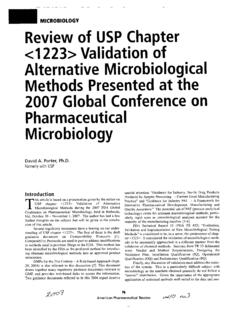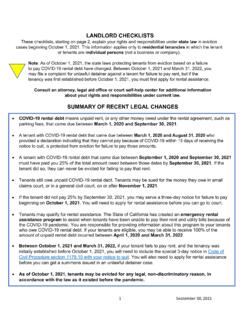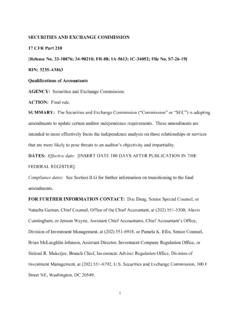Transcription of Microbiological Best Laboratory Practices, USP <1117 ...
1 MICROBIOLOGY. Microbiological Best The field of pharmaceutical microbiology is responsible for many key objectives in ensuring patient safety and product quality. Quality control, method development, process and product design, and product Laboratory Practices, USP. stability are a few of the objectives. The United States Pharmacopeia (USP), other global pharmacopeias and some parallel industry specific compendia offer some standardized test methodologies and material <1117> Value and Recent specifications relating to Microbiological quality and control. However these test methods assume significant operational knowledge on the part of the Laboratory practitioner and significant operational capabilities Changes to a Guidance of of the Laboratory itself. It is imperative to have some basic knowledge, experience and infrastructure that can support consistent use of these methods. The USP informational chapter <1117> Microbiology Best Quality Laboratory Practices Laboratory Practices was developed to serve a part of this purpose.
2 The proposed general information chapter about Microbiological Best Lab Practices was first published in 2003 (USP 2003) in the Pharmacopeial Forum, following the long standing USP Revision process of development and writing standards by experts along with public comment. After comments and further revision of the draft chapter (USP 2004), it was first published as an official USP Informational chapter in USP 29, 3 years later (USP 2006). Scott Sutton1, and Donald Singer2 The intent of the chapter was to address a perceived lack of clarity on the parts of both industry and the regulators on the basic requirements of President, Microbiology Network 1. infrastructure needed to support mandatory Microbiological criteria and Global Lead Manager, Microbiology R&D, GlaxoSmithKine 2. tests in the USP. Chemistry had a lot of guidance and information, but there was very little guidance for Microbiological testing. The question of Laboratory variability was central to this concern.
3 Microbiologists work every day with variability in the detection, recovery and growth of Microbiological species. This variability can be thought of in two categories, avoidable variability (variability due to poor practice). and inherently unavoidable variability (variability due to limitations of the methods and the vagaries of dealing with biological samples - see Jarvis, 1989). The goal of best practices would then, be to minimize avoidable Microbiological error. May/June 2011 | | 1. MICROBIOLOGY . What are Best Laboratory Practices' The Original Chapter in Microbiology? Media Preparation and Quality Control Well, they are a way of developing control or, in analytical terms, having a system suitability' of the Laboratory . It makes sense. Using and The quality of work in a Microbiological Laboratory depends on benchmarking best Laboratory practices plus good documentation the quality of the culture media. It is essential to use the correct practices ensures reliability of data.
4 In our highly regulated industry, media for the purpose at hand, although the correct media is not assurance is paramount to control. always obvious. For example, water testing is commonly performed with R2A agar, but many facilities use TSA (Trypticase Soy Agar). Note: we are not saying anything about Good Manufacturing Practices or HPCA (Heterotrophic Plate Count Agar) for this purpose. The (GMPs) although they certainly have a place in the discussion! We are recommendation is provided that the choice of media should be talking about Laboratory quality and best practice that goes well beyond consistent, appropriate and justified. 21 CFR (Code of Federal Regulations) whatever (211, 612, 820, etc). The goal of this is to minimize variability and erroneous results. A secondary An entire section is devoted to the question of media storage and the benefit is to provide a benchmark for the Laboratory and for auditors of effects this might have on the media quality. Excesses of heat and cold Laboratory functions.
5 Also, variability, inherent in microbiology, means are to be guarded against, as is the potential for dehydration of poured that Microbiological data deviations will happen. plates. Some guidance is also provided in quality control for molten media used in pour plates. What's in the Original Chapter? Maintenance of Microbial Cultures Second only to media, safeguarding the stock cultures is the most Let's take a look at the original USP chapter and its topics of discussion. important component of a successful microbiology Laboratory . These Figure 1 shows the integration of all the key topics: must be handled carefully at all times to avoid contamination. Media preparation The care of the cultures starts upon receipt. A careful stock culture Microbiological cultures curator will confirm the identity of the received cultures, even if they Lab equipment come from as respected a source as a national culture collection. Mistakes can happen. The use of an incorrect strain in a compendial test Laboratory layout could bring the results of weeks or months of work into question.
6 Lab records The chapter reinforces the compendial recommendation for the seed Interpretation of results lot technique in culture maintenance. Critical to this is the need to Training go into your containers of stock culture only once, and in restricting the number of passages. Now, it must be stated that there is nothing Documentation magic about the number 5. This number of passages gained popularity In the section about media preparation, the discussion included media in the compendia through its use in the Sterility Test, and has been preparation, media storage, and quality control testing of media. maintained for consistency. The point to the practice is that a careful lab will safeguard the purity and identity of their stock cultures by limiting the potential for drift due to excessive transfers. Maintenance of Laboratory Equipment This section was originally included more for the sake of completeness than because of concerns peculiar to the microbiology Laboratory .
7 Basic information on qualification requirements, documentation, etc. was included. Laboratory Layout and Operations The need for this section stems from the concern that too few facilities understand or plan for the separation of samples from a Microbiological Figure 1. perspective. The success of a Laboratory can be enhanced by the thoughtful separation of samples likely to have contamination from those that are expected to be sterile. 2 | | May/June 2011. MICROBIOLOGY . Training of Personnel Keep the chapter updated The chapter states plainly what should be common sense Improve clarity in recommending that microbiologists and managers in the Add more information that the public requested pharmaceutical support lab should have academic training in microbiology or allied health sciences. This recommendation is in line Now, let's take a look at the newly revised chapter, in Figure 2. with current best practice for biosafety as laid out in the 5th Edition of the center for Disease Control's (CDC) manual Biosafety in Microbiological Some new relevant topics were added: Lab Resources, Sample Handling, and Biomedical Laboratories (BMBL).
8 (CDC, 2007) and Media Incubation Times. In addition to the new topics, some modifications were made to the Documentation and Maintenance of language used to improve clarity and accuracy within these topics. Laboratory Records These sections were included only for the sake of completeness, although additional GMP Rules are added in this revision. It is nice to More Detail of the recent changes see the rules written down somewhere. One aspect of these sections should also be addressed, and that is the Introduction expectations when dealing with contract laboratories. The list of required Some clarifications were added to the Introduction. The sentence about bits of information for the lab write-up is designed to provide a minimal key parameters relating to equipment was modified, using the word amount of proactive documentation for GMP requirements. This is also operation' along with 'control' to indicate the importance of equipment a reasonable expectation for GMP studies from contract laboratories.
9 Performance. When discussing data variability, as mentioned earlier, we Many labs will accept little more than summary reports from the contract replaced the word known' with inherent' to enhance clarity about the lab; it is the opinion of the authors that this is an ill-reasoned position risk of variability in microbiology. as it prevents adequate QAU (Quality Assurance Unit) review of the study as required by 21 (b)12 & 15, 21 , 21 , Media Preparation and Quality Control Testing 21 CFR and 21 While it might be argued that the contract lab's QAU fulfills this requirement, this assumes that the client has The revised chapter expands the discussion of media preparation as complete and total confidence that the current Quality procedures and well. The recommendations include accurate weighing of dehydrated policies of the contract lab meet or exceed their own. components, the use of high-quality (USP Purified) water, as the first intent choice, completely dissolving the dehydrated media or Interpretation of Assay Results individual ingredients, and the need to control the heating of the This section was initially envisioned to provide information on Laboratory media to avoid damaging heat-labile components of the media.
10 Some investigations. However, during the writing process it became clear recommendations on the labeling and packaging of media are also that the scope of this section was broader than merely investigations, provided. A general change in the chapter is apparent in this section, and so the current title was settled upon as the best choice. with cross-references to various other relevant USP chapters added. This cross-referencing also raises expectations that the microbiology A discussion of the inherent variability of Microbiological data was lab will be familiar and compliant with these other chapters as well. For necessary in this chapter. One view of good Laboratory practices could instance, instead of explaining how to calibrate a balance, a reference be structured around determining practices that minimize variability was added for the USP General chapter about Weighing on an Analytical in the microbiology lab. However, because we are dealing with such Balance, USP <1251>.













